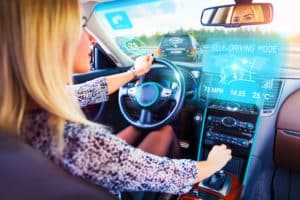Free Consultation
Free Consultation

In early August, Optimus Ride, an autonomous vehicle company, debuted it’s self-driving pilot program in Brooklyn. Six vehicles will operate in the Brooklyn Naval Yard. This industrial space is closed off from the public but houses over 400 companies and 10,000 employees. Because the space is considered private property, the vehicles do not have to deal with the chaos of NYC streets. Therefore, these cars avoid the unpredictability of both NY pedestrians and other vehicles. Although moving at fairly slow speeds, in between 10 and 15 MPH, the shuttle service transports passengers from the Naval Yard to the New York City Ferry dock, 1.1 miles away. It is expected that 500 passengers will use the free service every day.
These six-seat autonomous vehicles have a safety driver and a software operator present at all times. The safety driver sits directly behind the wheel, ready to take action when needed. The other operator sits in the passenger seat and monitors information regarding the vehicle from a computer. However, once the shuttle service becomes more established, engineers will operate the vehicle from the company offices and there will be no supervisors located in the cars. The company is aiming for this to happen by 2020.
Eventually, Optimus Ride plans to extend its shuttle service outside the Naval Yards and into more populated travel areas. But, since the streets of New York are so complex, the company is planning to ease its way in. In fact, the company has similar testing vehicles located in Virginia, California and multiple parts of Massachusetts, including areas of Boston.
Despite the late start, New York is finally the home to some autonomous vehicle tests. But is it here to stay?
Self-driving car companies faced many legal obstacles when attempting to test in New York. For example, New York Sate requires all drivers to have at least one hand on the steering wheel while operating a vehicle. The senate attempted to change this 1967 law, but failed. Some legislators who are against the amendment cite liability questions for their lack of support. New York does not even allow the self-parking feature in most cars to be used due to this law. Despite this, many autonomous vehicle owners, Tesla for instance, continue to use self-driving features. Drivers who break the one-hand law can receive tickets or fines.
When Gov. Cuomo approved a 1-year testing program on state roads in 2017, companies were reluctant to sign up. However, the new testing law allows hands-free driving to be tested, although a safety driver with a valid license must be present in the car and ready to take control at all times.
Despite the allowance of autonomous vehicles testing in New York, there are strict rules that must be followed on public roads. A state police vehicle must follow along with any testing car. Also, companies must pay $92 for every hour of testing and an additional 54 cents for every mile traveled. On top of that, companies must take out at $5 million insurance policy for each vehicle tested. In addition to these payments, companies must disclose the time, date, route and distance of each test before it occurs. This ensures that testing does not occur in school or construction zones.
After the 2017 testing period ended. However, a new two-year period began in April of 2018. The apprehension from most autonomous vehicle companies still continued though. As of now, the law that permits testing will expire in April of 2021.
As mentioned earlier, many companies have been reluctant to testing autonomous vehicles in New York because of the strict regulations. However, some companies have begun the testing process.
Audi was the first company to attempt testing in New York. It received approval from the DMV in 2017 and tested for s short period of time around Albany, the state capitol. The route consisted of 6.1 miles. However, shortly after beginning its testing, Audi pulled the plug. Many speculate it had something to do with the hefty prices of testing.
Cruise Automation, recently acquired by General Motors, was approved for testing in 2018 but only had three months to test due to limitations. The company debuted its testing with the Chevy Bolt EV in Lower Manhattan. Despite these plans, Cruise Automation never tested any autonomous vehicles in New York, but instead focused most of their efforts in San Francisco.
Cities including Pittsburgh and Phoenix have received a lot of testing inquiries from many companies. There are over 40 corporations working on the production and development of autonomous vehicles. However, most of them refuse to go anywhere near New York. Optimus Ride seems like a step in the right direction but may not be as optimistic as it looks. DMV permission is not needed since they only test on private roads. Therefore, no payment is necessary. But, will these autonomous vehicles ever make it to the mainstream streets of New York if they must follow the strict regulations?
Autonomous vehicles are uncharted territory in the legal world. Laws and regulation regarding safe driving and operation of these vehicles are lacking. Who is responsible for accidents involving self-driving vehicles? Now that New York houses a few autonomous technology companies, you may be in danger of a self-driving car accident.
If you were injured in a car accident, especially one where a autonomous vehicle may be a fault, you should contact a lawyer immediately. Get in touch with our experienced injury attorneys by email or by calling (718) 364-4000 for important information and advice. You can also fill out one of our case intake forms, and we will have one of our attorneys get right back to you.